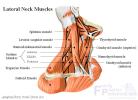Congenital Torticollis
- Etiologies
- Pathophysiology
- Unilateral shortening of sternocleidomastoid Muscle
- Associated Conditions
- Congenital asymmetric contractures of hip abductors
- Unilateral Congenital Hip Dysplasia
- Unilateral Metatarsus Adductus
- Signs
- Radiology
- Neck XRay
- Indicated for significantly limited neck ROM
-
Ultrasound Hips
- Assess for concurrent Congenital Hip Dysplasia
- Indicated for significant hip abductor tightness
- Management
- Positioning head opposite affected side
- Padded bricks
- Sandbags
- Passive Stretching
- Rotate infants head to affected side
- Tilt head backwards (extend) away from affected side
- Surgical release of sternocleiodomastoid Muscle
- Indicated for limited range of motion at 1 year
- Course
- Minimal signs at birth
- Torticollis evident by 2 to 3 weeks
- Recovery over 3 to 4 months with therapy
- Complete resolution by 1 year with therapy
- Complications
